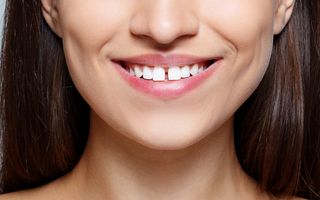
Patient education
Good oral and dental hygiene can help prevent bad breath, tooth decay and gum disease—and can help you keep your teeth as you get older.
Patient education
Good oral and dental hygiene can help prevent bad breath, tooth decay and gum disease—and can help you keep your teeth as you get older.
Regular Brushing and Flossing
Proper brushing takes at least two minutes — that’s right, 120 seconds! Most adults do not come close to brushing that long. To get a feel for the time involved, try using a stopwatch. To properly brush your teeth, use small circular motions, angling the toothbrush bristles 45° toward the gum-line, and concentrate on thoroughly cleaning each section as follows:
- Clean the outer surfaces of your lower teeth, then follow around to the inner surfaces of the lower teeth
- Clean the outer surfaces of your upper teeth, then follow around to the inner surfaces of the upper teeth
- Clean the chewing surfaces
- For fresher breath, be sure to brush your tongue, too
At Kissing Point Dental we believe a soft-bristled brush is best for removing plaque and debris from your teeth. Small-headed brushes are also preferable, since they can better reach all areas of the mouth, including hard-to-reach back teeth. For many, a powered toothbrush is a good alternative. It can do a better job of cleaning teeth, particularly for those who have difficulty brushing or who have limited manual dexterity.
It is important that you use a toothpaste that’s right for you. Today there is a wide variety of toothpaste designed for many conditions, including cavities, gingivitis, tartar, stained teeth and sensitivity. Ask Dr Osie or Tia which toothpaste is right for you.
You should replace your toothbrush when it begins to show wear, or every three months, whichever comes first. Our hygienist will provide you with a new toothbrush when you come for your 6 monthly continuing care appointments.
Proper flossing removes plaque and food particles in places where a toothbrush cannot easily reach — under the gum-line and between your teeth. Because plaque build-up can lead to tooth decay and gum disease, daily flossing is highly recommended.
To receive maximum benefits from flossing, use the following proper technique:
- Starting with about 18 inches of floss, wind most of the floss around each middle finger, leaving an inch or two of floss to work with
- Holding the floss tautly between your thumbs and index fingers, slide it gently up-and-down between your teeth
- Gently curve the floss around the base of each tooth, making sure you go beneath the gumline. Never snap or force the floss, as this may cut or bruise delicate gum tissue
- Use clean sections of floss as you move from tooth to tooth
- To remove the floss, use the same back-and-forth motion to bring the floss up and away from the teeth.
Continuing Care
During your initial visit and your continuing care appointments, we will assess your home care and gum health and provide you with customised instruction to ensure you’re effectively removing plaque from the teeth and gums-lines.
Dental disease such as cavities and gum disease are the result of plaque that has been left on the teeth and the gums too long. By regularly and effectively removing plaque, you can prevent dental disease.
Sure, a regular check-up and clean with our hygienist promotes good oral hygiene, but did you know it can also prevent a multitude of diseases? That 2 o’clock chair-side rendezvous may not seem nearly as exciting as a late lunch with a friend or those new shoes, but it will be well worth it in the end. Here are 10 really great reasons to stick with your regular 6 monthly prevention appointments!
- Earlier Oral Cancer detection. You may or may not realise that you’re screened for oral cancer during your regular check-up & clean. According to the Oral Cancer Foundation, someone dies of oral cancer every hour of every day. It’s a sad proposition, especially when you consider that it is highly curable with early diagnosis.
- It Wards Off Gum Disease. Gum disease, or an infection in the gum tissues and bone that keep your teeth in place, is one of the leading causes of adult tooth loss. It can be treated and reversed if diagnosed early. Unfortunately, not receiving treatment will lead to a more serious and advanced state of gum disease. Regular check-up & cleans and daily brushing and flossing are key weapons in the fight against these conditions.
- It’s About More Than Your Mouth. Sure, not getting regular check-ups may make you less kissable, but did you know that studies have linked heart attacks and strokes to gum disease associated with poor oral hygiene? A trip to our practice every 6 months could reduce your risk of serious health problems!
- Gum Disease Is Now Linked To Cancer. Lancet Oncology has confirmed that the presence of moderate gum disease contributed to a 14% risk of lung, kidney and blood cancers in both smokers and non-smokers. Chronic advanced gum disease was the most frightening – with an additional fourfold increase of head and neck cancer for each millimetre of related bone loss around teeth.
- You Want to Preserve Your Smile. As mentioned, gum disease is one of the leading causes of tooth loss in adults. To keep your pearly whites intact, regular gum analysis and professional cleans are essential.
- It’s Best to Detect Dental Problems Early. We’ve already touched upon early detection of gum disease and oral cancer, but don’t overlook more basic dental problems. Cavities and broken fillings are easy to treat. Without regular trips to the dentist, these problems can lead to root canals, gum surgery and tooth extraction. Which sounds worse: A 45-minute check-up and clean or an hour under the knife?
- Dental problems are preventable. Cavities, gum disease and tooth loss aren’t a part of life or the natural aging process. These problems are easily preventable and this is a lot more cost effective than waiting for holes to develop, teeth to break or those awful tooth aches which can prevent sleep and ruin your weekend.
- You Want to Know You’re Doing it Right. Maybe you bought a fancy new electric toothbrush, or aren’t keeping up with what current research has to say about caring for your teeth. Either way, check-ups allow us to examine your mouth and keep you on the right path.
- You Want to Upgrade Your Smile. If you’re already suffering from tooth decay or gum problems, regular appointments will allow our office to create a personalised treatment plan that will give you the best smile possible.
- You Want to Dazzle. Regular cleanings remove most tobacco, coffee and tea stains, polishing your teeth to a beautiful shine!
If it’s been more than 6 months since your last check up and clean, call us on 9488 9699 to schedule an appointment today!
Other Dental Concerns

Gaps & Spaces

Missing Teeth

Crowded Teeth

Discoloured Teeth

Damaged & Worn Teeth

Toothache

Sensitive Teeth


